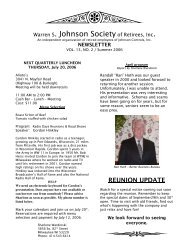Rxf - Johnson Controls Inc.
Rxf - Johnson Controls Inc.
Rxf - Johnson Controls Inc.
You also want an ePaper? Increase the reach of your titles
YUMPU automatically turns print PDFs into web optimized ePapers that Google loves.
Pressure gauge - Discharge Port<br />
1. High reading would indicate:<br />
a. High viscosity and small and/or long discharge line.<br />
b. Gate valve partially closed.<br />
c. Filter plugged.<br />
d. Vertical head did not consider a high specific gravity<br />
liquid.<br />
e. Line partially plugged from buildup on inside of pipe.<br />
f. Liquid in pipe not up to temperature.<br />
g. Liquid in pipe has undergone a chemical reaction and<br />
has solidified.<br />
h. Relief valve set too high.<br />
2. Low reading would indicate:<br />
a. Relief valve set too low<br />
b. Relief valve poppet not seating properly.<br />
c. Too much extra clearance.<br />
d. Pump worn.<br />
3. Fluttering, jumping, or erratic reading:<br />
a. Cavitation.<br />
b. Liquid coming to pump in slugs.<br />
c. Air leak in suction line.<br />
d. Vibrating from misalignment or mechanical problems.<br />
Some of the following may also help pinpoint the problem:<br />
1. Pump does not pump.<br />
a. Lost its prime - air leak, low level in tank.<br />
b. Rotating in wrong direction.<br />
c. Motor does not come up to speed.<br />
d. Suction and discharge valves not open.<br />
e. Strainer clogged.<br />
f. Relief valve set too low, relief valve poppet stuck open.<br />
g. Pump worn out.<br />
h. Any changes in the liquid system, or operation that<br />
would help explain the trouble, e.g. new source of<br />
supply, added more lines, inexperienced operators,<br />
etc.<br />
i. Tighten end clearance.<br />
j. Head position incorrect.<br />
2. Pump starts, then loses its prime.<br />
a. Low level in tank.<br />
b. Liquid vaporizing in the suction line.<br />
c. Air leaks or air pockets in the suction line; leaking air<br />
through packing or mechanical seal.<br />
d. Worn out.<br />
3. Pump is noisy<br />
a. Pump is being starved (heavy liquid cannot get to pump<br />
fast enough). <strong>Inc</strong>rease suction pipe size or reduce<br />
length.<br />
b. Pump is cavitating (liquid vaporizing in the suction<br />
line). <strong>Inc</strong>rease suction pipe size or reduce length; if<br />
pump is above the liquid, raise the liquid level closer<br />
to the pump; if the liquid is above the pump, increase<br />
the head of liquid.<br />
c. Check alignment.<br />
d. May have a bent shaft or rotor tooth. Straighten or<br />
replace.<br />
e. May be a foreign object trying to get into the pump<br />
through the suction port.<br />
4. Pump not up to capacity<br />
a. Starving or cavitating - increase suction pipe size or<br />
reduce length.<br />
b. Strainer partially clogged - clean.<br />
c. Air leak in suction piping or along pump shaft.<br />
d. Running too slowly - is motor the correct speed and<br />
is it wired up correctly<br />
e. Relief valve set too low or stuck open.<br />
RXF ROTARY SCREW COMPRESSOR UNITS<br />
MAINTENANCE<br />
070.410-IOM (JUL 11)<br />
Page 29<br />
f. Pump worn out.<br />
g. Tighten end clearance.<br />
h. Head position incorrect.<br />
5. Pump takes too much power.<br />
a. Running too fast - is correct motor speed, reducer<br />
ratio, sheave size, etc. being used.<br />
b. Liquid more viscous than unit sized to handle - heat<br />
the liquid, increase the pipe size, slow the pump down,<br />
or get a bigger motor.<br />
c. Discharge pressure higher than calculated - check with<br />
pressure gauge. <strong>Inc</strong>rease size or reduce length of pipe,<br />
reduce speed (capacity), or get bigger motor.<br />
d. Pump misaligned.<br />
e. Extra clearance on pumping elements may not be<br />
suffi cient for operating conditions. Check parts for<br />
evidence of drag or contact in pump and increase<br />
clearance where necessary<br />
6. Rapid Wear.<br />
Examination of a pump that has gradually lost its ability to<br />
deliver capacity or pressure would show a smooth wear pattern<br />
on all parts. Rapid wear shows up as heavy grooving,<br />
galling, twisting, breaking, or similar severe signs of trouble.<br />
RECOMMENDED MAINTENANCE PROGRAM<br />
In order to obtain maximum compressor unit perfor mance<br />
and ensure reliable operation, a regular main tenance program<br />
should be followed (see Maintenance Schedule):<br />
The compressor unit should be checked daily for leaks, abnormal<br />
vibration, noise, and proper opera tion. A daily log should<br />
also be maintained. There should be a continued monitoring<br />
of oil quality and oil analysis testing. In addition, an analysis<br />
of the unit’s vibration should be made periodically.<br />
VIBRATION ANALYSIS<br />
Periodic vibration analysis can be useful in detecting bearing<br />
wear and other mechanical failures. If vibration analysis is<br />
used as a part of your preventive main tenance program, take<br />
the following guidelines into considera tion.<br />
1. Always take vibration readings from exactly the same<br />
places, at exactly the same percent of load.<br />
2. Use vibration readings taken from the new unit at start-up<br />
as the base line reference.<br />
3. Evaluate vibration readings carefully as the instrument<br />
range and function used can vary. Findings can be easily<br />
misinterpreted.<br />
4. Vibration readings can be influenced by other equipment<br />
operating in the vicinity or connected to the same piping as<br />
the unit. For additional information, request Frick ® publication<br />
E70-902 IB.<br />
OIL QUALITY and ANALYSIS<br />
High quality refrigeration oil is necessary to ensure compressor<br />
longevity and reliability. Oil quality will rapidly deteriorate<br />
in refrig eration systems containing moisture and air or other<br />
contaminants. In order to ensure the quality of the refrigeration<br />
oil in the com pressor unit.<br />
DO NOT MIX OILS of different<br />
brands, manufacturers, or types.<br />
Mixing of oils may cause excessive<br />
oil foaming, nuisance oil level cutouts, oil pressure loss,<br />
gas or oil leakage and catastrophic compressor failure.


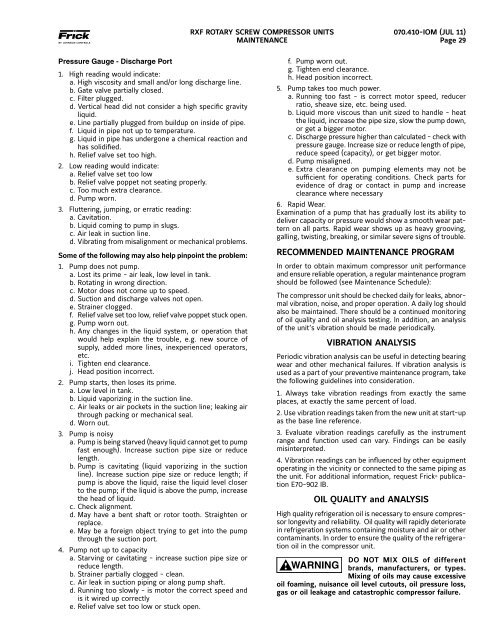
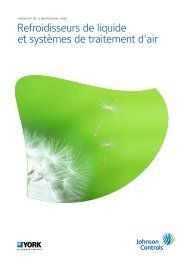


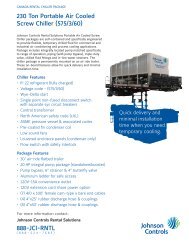


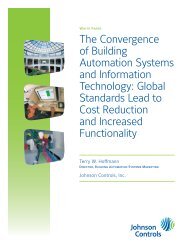
![[PDF] Intelligent Fire Annunciator IFA-1000 - Johnson Controls Inc.](https://img.yumpu.com/7424420/1/190x245/pdf-intelligent-fire-annunciator-ifa-1000-johnson-controls-inc.jpg?quality=85)


